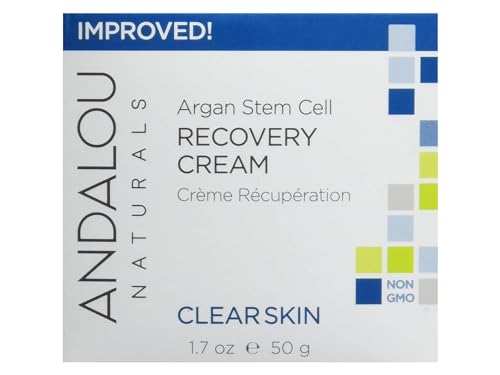
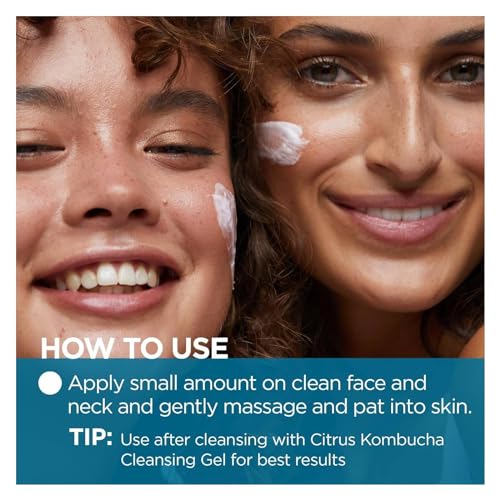
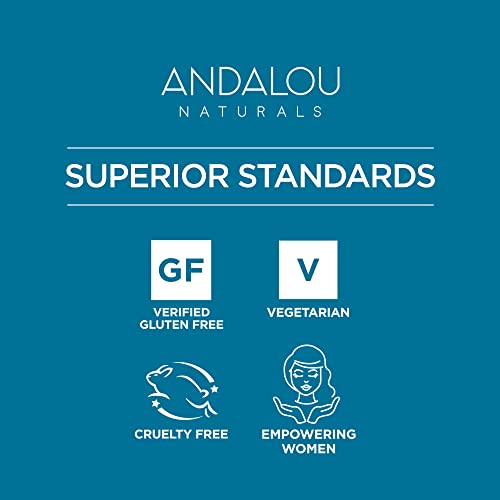
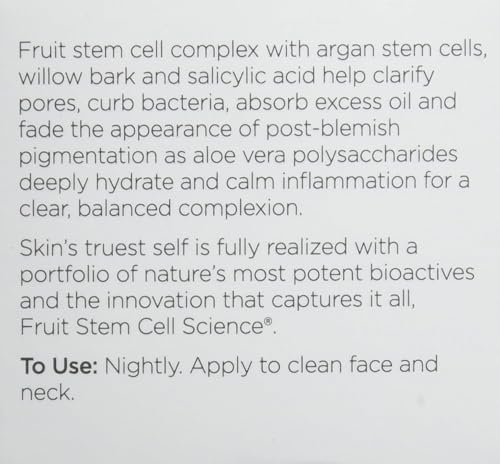
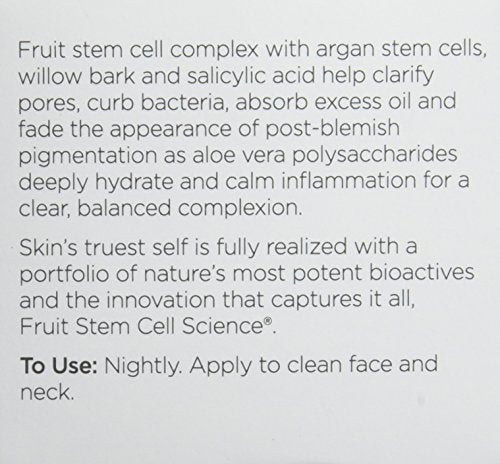
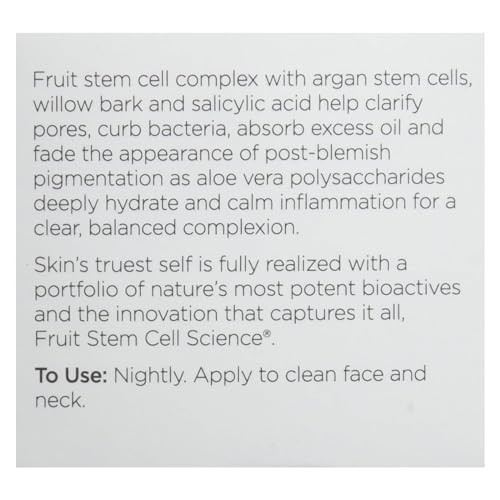
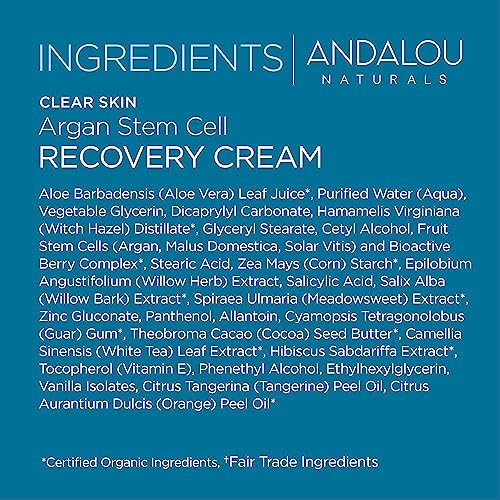
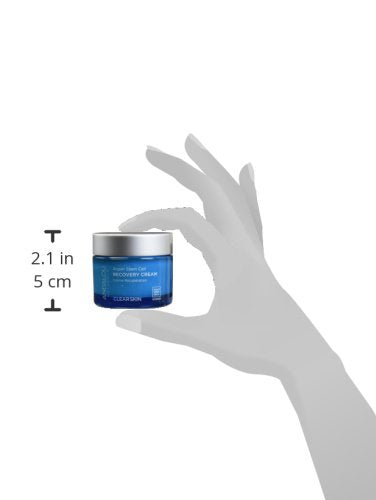
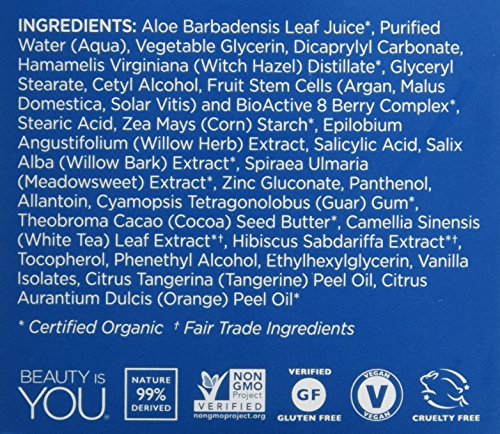
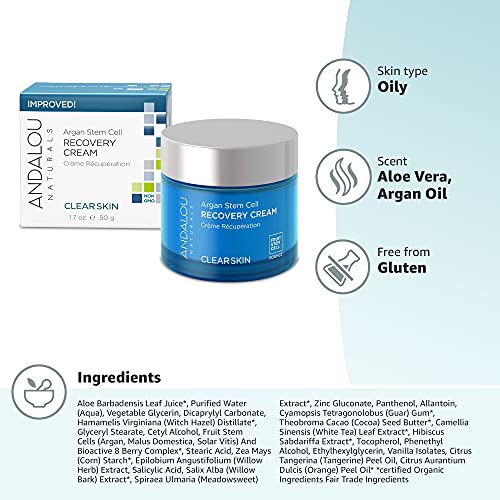
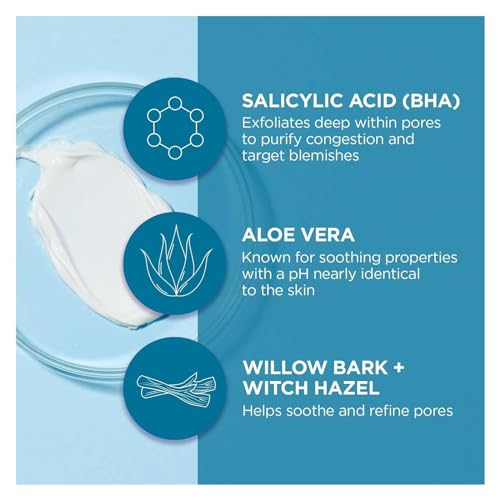
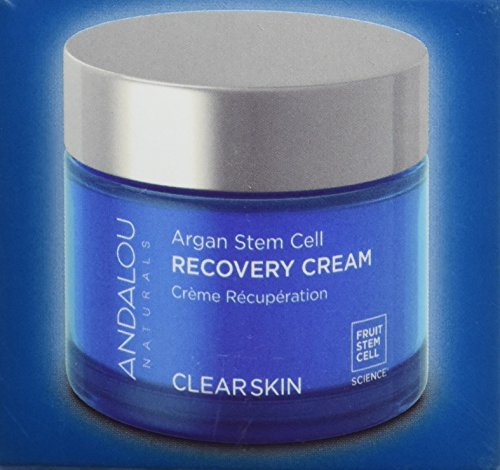
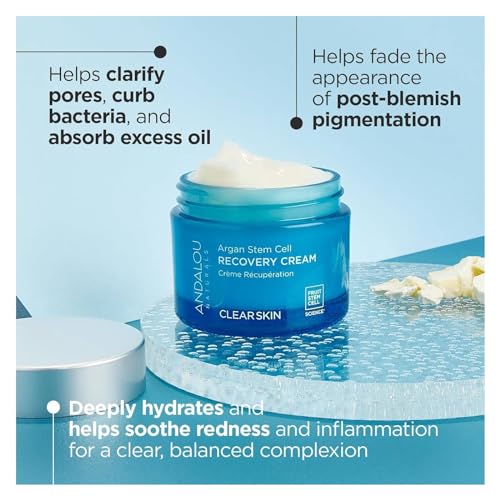
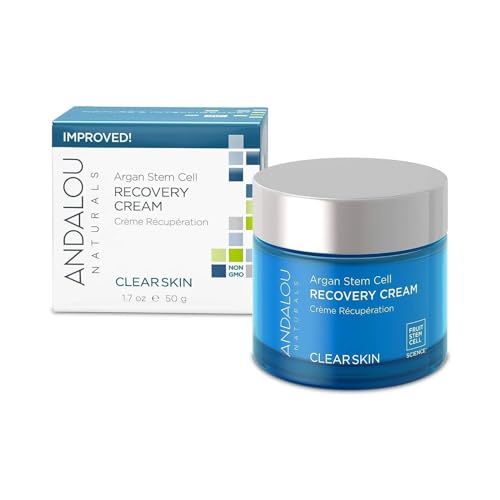
Andalou Naturals Face Cream - Clarifies Pores, Calms Oily Skin, Non-GMO - 1.7oz


Salicylic Acid
High RiskSalicylic acid is a naturally occurring and synthetic compound primarily used in skincare products for its ability to exfoliate skin, unclog pores, and treat acne. It is a beta hydroxy acid (BHA) that penetrates the skin to effectively reduce inflammation and promote cell turnover.
Sustai Insights
Salicylic acid is recognized for its effective acne treatment properties and ability to enhance skin absorption, making it beneficial in various formulations. However, its use is subject to restrictions due to potential adverse health effects such as skin irritation and enhanced absorption risks. Regulatory bodies have cautioned against high concentrations, marking it as a high-risk ingredient. Special consideration should be given to sensitive populations, and safer alternatives like glycolic acid may be explored to minimize risks.
Zinc Gluconate
High RiskZinc gluconate is a zinc salt derived from gluconic acid, commonly used in dietary supplements and topical formulations. It serves primarily as a source of zinc, an essential mineral that supports various biological functions, including immune response and skin health.
Sustai Insights
Zinc gluconate provides functional benefits as a zinc source, contributing to immune support and skin health. However, it is associated with high usage restrictions and potential environmental persistence and bioaccumulation concerns. Health-wise, it presents low risks for carcinogenicity, allergies, and reproductive toxicity. Regulatory advisories limit its use in certain products, reflecting an overall high risk assessment. Safe usage practices should be followed, and alternatives like zinc oxide may be considered for those seeking different formulations.
Cyamopsis Tetragonoloba (Guar) Gum
Medium RiskCyamopsis tetragonoloba (guar) gum is a resinous substance derived from the seeds of the guar plant. It primarily functions as a thickening and stabilizing agent in various cosmetic and personal care products, enhancing texture and consistency.
Sustai Insights
Guar gum is valued for its thickening capabilities and is derived from a renewable source, contributing to its sustainability credentials. However, it poses moderate allergenic potential and low risks for carcinogenicity and reproductive toxicity. Environmental concerns are minimal, with no significant pollutant or bioaccumulation risks identified. Regulatory status is favorable, with no major restrictions noted. Users should practice caution with sensitive individuals, and alternatives like xanthan gum may serve as effective substitutes. Overall, the risk level associated with guar gum is assessed as medium, warranting careful consideration in product formulation.
Unspecified Extracts
Medium RiskUnspecified extracts refer to a placeholder substance page for skin care formulations, often derived from various natural sources. These extracts are utilized for their potential benefits in maintaining skin health and enhancing product efficacy, but specific functions may vary depending on the source and formulation.
Sustai Insights
Unspecified extracts can provide functional benefits such as enhancing product stability and moisturizing properties. However, they may pose health risks, including low potential for allergies and irritations. Environmental concerns may arise if sourced unsustainably. Regulatory bodies impose minimal restrictions, indicating low risk overall. Safe usage and alternatives are advisable, leading to a medium risk assessment.
Phenethyl Alcohol
Medium RiskPhenethyl alcohol is an aromatic alcohol commonly used in cosmetic formulations. It functions primarily as a solvent and a preservative, contributing to product stability and enhancing the fragrance profile.
Sustai Insights
Phenethyl alcohol exhibits functional benefits as a preservative and solvent in cosmetic products, with some sustainability credentials due to its natural origin. However, it is associated with moderate allergy concerns and low risks of carcinogenicity and reproductive toxicity. Regulatory bodies have imposed specific use restrictions, highlighting the need for cautious application. Overall, the risk assessment indicates a medium risk level, warranting safe usage practices and consideration of alternatives like natural preservatives.
Citrus Aurantium Dulcis (Orange) Oil
Medium RiskCitrus aurantium dulcis (orange) oil is a volatile oil extracted from the fresh peel of oranges. It is commonly used in cosmetic and personal care products for its fragrance and potential skin benefits.
Sustai Insights
Citrus aurantium dulcis (orange) oil offers functional benefits as a natural fragrance and may provide skin conditioning effects. However, it has a high allergenic potential, posing risks of skin irritation and allergic reactions. Environmental concerns include moderate persistence and potential bioaccumulation. Regulatory bodies may impose usage restrictions, indicating a medium overall risk level. For safe use, it's advisable to patch test and consider alternatives like other citrus oils or synthetic fragrances to mitigate allergy risks.
Camellia Sinensis (Green Tea) Extract
Medium RiskCamellia sinensis (green tea) extract is derived from the leaves of the Camellia sinensis plant, commonly used in cosmetics and personal care products for its antioxidant properties. It serves as a skin conditioning agent and can provide a soothing effect due to its natural compounds.
Sustai Insights
Green tea extract offers functional benefits such as antioxidant properties that may protect skin from oxidative stress. However, it poses moderate allergenic potential and should be used cautiously by sensitive individuals. Environmentally, it is considered low risk, with no significant bioaccumulation or pollution concerns. Regulatory bodies have not imposed severe restrictions, but users should maintain safe application practices. Overall, the ingredient presents a medium risk profile due to its potential health and environmental impacts.
Glycerin
Medium RiskGlycerin (also called glycerol) is a naturally occurring compound commonly used in personal care and cosmetic products. It functions as a humectant, attracting moisture to the skin, and is also utilized as a solvent and emollient to enhance product texture and stability.
Sustai Insights
Glycerin is valued for its effective moisturizing properties and biodegradability, making it a widely accepted ingredient in formulations. It poses low health risks, including low concerns for carcinogenicity and allergies. However, moderate use restrictions exist due to regulatory guidelines. While glycerin does not significantly contribute to environmental pollution, its production process should be ethically sourced. Overall, glycerin holds a medium risk level, emphasizing the importance of safe usage practices and considering sustainable alternatives.
Zea Mays (Corn) Starch
Low RiskZea mays (corn) starch is a starch obtained from corn kernels, primarily used as a thickening and stabilizing agent in various cosmetic and food products. It serves as a binder and enhances texture, contributing to the overall formulation's consistency and stability.
Sustai Insights
Zea mays (corn) starch offers functional benefits such as acting as a thickening and stabilizing agent, which helps improve product texture. It is sustainably sourced and biodegradable, posing low health risks, including negligible concerns for carcinogenicity and allergies. Environmental risks are minimal, with no significant pollutant potential noted. Regulatory bodies have not issued advisories, indicating a low overall risk level. Safe usage practices involve ensuring appropriate concentrations in formulations. Alternatives include other plant-based starches or thickeners, which may offer similar functional benefits while maintaining sustainability.
Spiraea Ulmaria (Meadowsweet) Extract
Low RiskSpiraea ulmaria extract is derived from the flowers of the meadowsweet plant and is commonly used in cosmetic formulations. It is recognized for its soothing properties and is often included for its potential benefits in skin care applications.
Sustai Insights
Spiraea ulmaria extract offers functional benefits such as anti-inflammatory and astringent properties, making it useful in soothing skin formulations. It is considered to have low health risks, with no significant concerns for carcinogenicity, allergies, or reproductive toxicity. Environmental impact appears minimal, with no evidence of pollutant potential or bioaccumulation. Regulatory status indicates no restrictions. Overall, this ingredient poses a low risk, making it a viable option in cosmetic products.
Epilobium Angustifolium (Willow Herb) Extract
Low RiskEpilobium angustifolium extract is derived from the leaves and flowers of the willow herb plant, commonly used in cosmetics for its soothing and anti-inflammatory properties. It is often incorporated into formulations aimed at calming irritated skin and promoting overall skin health.
Sustai Insights
Epilobium angustifolium extract provides functional benefits such as anti-inflammatory and soothing effects, making it valuable in skin care. It is sustainably sourced and poses low health risks, including minimal concerns regarding carcinogenicity, allergies, and reproductive toxicity. Environmentally, it is not classified as a pollutant. Regulatory status indicates no current restrictions. Overall, the ingredient is assessed as low risk, with safe usage practices recommended. Alternatives may include other plant extracts with similar soothing properties.
Hibiscus Rosa Sinensis (Chinese Hibiscus) Extract
Low RiskHibiscus rosa-sinensis extract is an extract obtained from the flowers of the Chinese hibiscus plant. It is commonly used in cosmetic and personal care products for its potential moisturizing and antioxidant properties.
Sustai Insights
Hibiscus rosa-sinensis extract offers functional benefits, including moisturization and antioxidant activity, making it suitable for skin care formulations. It is not associated with significant health risks such as carcinogenicity or irritations, and its environmental impact is minimal, posing low pollution risk. Regulatory assessments indicate no restrictions on its use. Overall, the ingredient is safe for cosmetic applications with a low risk profile. Alternatives for similar benefits include other plant extracts like aloe vera or green tea.
Stearic Acid
Low RiskStearic acid is a naturally occurring fatty acid commonly found in animal and vegetable fats. It functions primarily as an emulsifier, thickener, and stabilizer in cosmetic and personal care products, providing texture and consistency.
Sustai Insights
Stearic acid offers functional benefits such as effective emulsification and stabilization of formulations. It is derived from renewable sources and is biodegradable, contributing to its sustainability profile. Health risks are low, with minimal concerns regarding carcinogenicity, allergies, or reproductive toxicity. Environmental risks are also low, with no significant pollutants or bioaccumulation concerns noted. Regulatory bodies, including the FDA, do not impose restrictions on its use. Overall, stearic acid is assessed as low risk, and its safe usage practices are well-established, with no significant alternatives needed.
Allantoin
Low RiskAllantoin is a naturally occurring nitrogenous compound found in various plants and animals. It is commonly used in cosmetic formulations for its soothing and moisturizing properties, as well as its ability to promote skin cell turnover and healing.
Sustai Insights
Allantoin offers functional benefits such as skin soothing, hydration, and promoting cell regeneration. It is generally recognized as safe, with low concerns regarding carcinogenicity, allergies, and reproductive toxicity. Environmentally, it poses minimal risks, being biodegradable and sustainably sourced. Regulatory bodies do not impose significant restrictions on its use. Overall, the risk level associated with allantoin is low, making it a favorable ingredient in personal care products.
Theobroma Cacao (Cocoa) Seed Butter
Low RiskTheobroma cacao (cocoa) seed butter is extracted from the roasted seeds of the cocoa plant. It is commonly used in cosmetics and skincare products for its emollient properties, helping to moisturize and soften the skin. Cocoa butter is also known for its stability and resistance to rancidity.
Sustai Insights
Cocoa butter is recognized for its effective moisturizing properties and is sustainably sourced, contributing to its appeal in personal care products. It poses low health risks, with minimal concerns regarding carcinogenicity, allergies, or reproductive toxicity. Environmentally, it does not significantly contribute to pollution or bioaccumulation. Regulatory bodies impose few restrictions, affirming its safety. Overall, the risk associated with cocoa seed butter is low, making it a favorable ingredient in cosmetics. Alternatives include shea butter or plant oils for similar emollient benefits.
Salix Alba (White Willow) Bark Extract
Low RiskSalix alba (white willow) bark extract is an extract derived from the bark of the white willow tree. It is primarily known for its use in various cosmetic and personal care products, where it functions as an anti-inflammatory and soothing agent.
Sustai Insights
Salix alba bark extract offers functional benefits such as anti-inflammatory properties, which can aid in skin soothing and irritation reduction. It is generally considered low risk regarding health concerns, including carcinogenicity and allergies. Regulatory bodies, including the FDA, have not flagged it for significant health risks. Environmentally, it does not contribute substantially to pollution or bioaccumulation. Overall, this ingredient is assessed as low risk, with safe usage practices recommended. Alternatives can include other plant-based extracts with similar properties.
Hamamelis Virginiana (Witch Hazel)
Low RiskHamamelis virginiana, commonly known as witch hazel, is a botanical extract derived from the bark and leaves of the witch hazel plant. It is primarily used in cosmetic formulations for its astringent and soothing properties, often included in toners and skin care products to help reduce inflammation and tighten skin.
Sustai Insights
Witch hazel offers functional benefits as a natural astringent, helping to soothe irritated skin and reduce inflammation. It is generally recognized as safe, with low concerns for carcinogenicity, allergies, or developmental toxicity. Environmental risks are minimal, as it is not considered a pollutant or bioaccumulative. Regulatory bodies do not impose significant restrictions on its use. While enhanced skin absorption is noted, overall health and environmental risks remain low, indicating a favorable profile in cosmetic applications. Alternatives include other botanical extracts with similar properties, but witch hazel maintains a strong safety record.
Malus Domestica Fruit Cell Culture
Low RiskMalus domestica fruit cell culture refers to the cellular extracts derived from the apple tree, primarily used in cosmetic formulations for its potential skin benefits. It serves as a source of antioxidants and may contribute to skin conditioning properties in various products.
Sustai Insights
Malus domestica fruit cell culture offers functional benefits such as antioxidant properties, potentially aiding in skin rejuvenation and hydration. It is not associated with significant health risks, including low concerns for carcinogenicity and allergens. Environmental risks are minimal, with no noted bioaccumulation. Regulatory status is clear, as it is not restricted in major regions. Overall, the risk level is low, and safe usage practices are recommended. Alternatives may include other fruit cell cultures for similar benefits.
Panthenol
Low RiskPanthenol, a derivative of vitamin B5, is commonly used in cosmetic formulations for its moisturizing and skin-conditioning properties. It acts as a humectant, helping to retain moisture in the skin and hair, thereby improving hydration and texture.
Sustai Insights
Panthenol offers functional benefits such as effective hydration and skin conditioning, making it valuable in various cosmetic products. It is considered low risk regarding health impacts, with minimal concerns about carcinogenicity, allergies, or reproductive toxicity. Environmental risks are also low, with no significant pollutant or bioaccumulation potential. Regulatory bodies have not imposed restrictions on its use. Safe usage practices include adhering to recommended concentrations. Alternatives like glycerin may provide similar moisturizing benefits, but overall, panthenol is assessed as a low-risk ingredient.
Tocopherol
Low RiskTocopherols are a class of naturally occurring compounds, primarily known for their role as antioxidants. They are commonly used in cosmetic and skincare products to help stabilize formulations and protect ingredients from oxidative damage.
Sustai Insights
Tocopherols provide functional benefits such as antioxidant protection and skin conditioning. They are generally recognized as safe, with low concerns regarding carcinogenicity, allergies, and reproductive toxicity. However, enhanced skin absorption and potential endocrine disruption are noted. Regulatory bodies have not imposed significant restrictions on tocopherols, categorizing the overall risk as low. Safe usage practices should be observed, and while alternatives exist, tocopherols remain a viable option in formulations.
Cetyl Alcohol
Low RiskCetyl alcohol is a long-chain organic alcohol commonly used in cosmetic formulations. It serves as an emollient, emulsifier, and thickening agent, enhancing the texture and stability of products. Cetyl alcohol is derived from natural sources, such as coconut or palm oil, and is often included in creams, lotions, and hair conditioners.
Sustai Insights
Cetyl alcohol offers functional benefits as an emollient and emulsifier, improving product texture and stability. It is biodegradable and sourced from renewable materials, contributing to sustainability. Health risks are minimal, with low concerns for carcinogenicity, allergies, or reproductive toxicity. Environmental impact is also low, with no significant pollutant or bioaccumulation potential. Regulatory bodies have not placed restrictions on its use, indicating a favorable safety profile. Overall, cetyl alcohol is assessed as low risk, and safe usage practices include ensuring proper formulation concentrations.
Ethylhexylglycerin
Low RiskEthylhexylglycerin is a glyceryl ether utilized primarily as a skin-conditioning agent and preservative in cosmetic formulations. It enhances the efficacy of preservatives and serves as a humectant, helping to retain moisture in the skin. This ingredient is commonly found in various personal care products.
Sustai Insights
Ethylhexylglycerin offers functional benefits as an effective preservative and skin-conditioning agent, contributing to product longevity and moisture retention. Health risks are generally low, with minor concerns regarding allergic contact dermatitis and irritant potential. Environmentally, it poses minimal risks, not being recognized as a pollutant or bioaccumulative. Regulatory bodies have imposed few restrictions, indicating its safety for use. Overall, its risk level is assessed as low, making it a viable option in cosmetic formulations. For those seeking alternatives, ingredients like propanediol may serve similar functions with potentially lower irritation profiles.
Glyceryl Monostearate
Low RiskGlyceryl monostearate is a monoester of glycerol and stearic acid, commonly used as an emulsifier and stabilizer in food and cosmetic products. It helps blend oil and water-based ingredients, improving product texture and consistency.
Sustai Insights
Glyceryl monostearate offers functional benefits as an effective emulsifier, enhancing product stability and texture. It is derived from natural sources and is considered biodegradable. Health risks associated with it are low, as it shows no significant carcinogenic, allergenic, or reproductive toxicity effects. Environmental concerns are minimal, with no known pollutant or bioaccumulation issues. Regulatory bodies have not restricted its use, and it is generally regarded as safe. Overall, glyceryl monostearate presents a low risk profile, making it a suitable ingredient in various applications.
Aloe Barbadensis (Aloe Vera) Leaf Juice
Low RiskAloe barbadensis (aloe vera) leaf juice is derived from the succulent aloe vera plant, known for its hydrating and soothing properties. It is commonly used in cosmetic formulations for its moisturizing effects and is often included in products aimed at skin care and healing.
Sustai Insights
Aloe vera leaf juice offers functional benefits as a moisturizer and skin soothing agent, while being sustainably sourced and biodegradable. Health risks are low, with minimal concerns regarding carcinogenicity, allergies, and reproductive toxicity. Environmental impact is also low, with no significant pollutants identified. Regulatory agencies impose few restrictions. Overall, the ingredient poses a low risk, making it a favorable choice in cosmetic formulations.
Cyamopsis Tetragonoloba (Guar) Gum
Medium RiskCyamopsis tetragonoloba (guar) gum is a resinous substance derived from the seeds of the guar plant. It primarily functions as a thickening and stabilizing agent in various cosmetic and personal care products, enhancing texture and consistency.
Sustai Insights
Guar gum is valued for its thickening capabilities and is derived from a renewable source, contributing to its sustainability credentials. However, it poses moderate allergenic potential and low risks for carcinogenicity and reproductive toxicity. Environmental concerns are minimal, with no significant pollutant or bioaccumulation risks identified. Regulatory status is favorable, with no major restrictions noted. Users should practice caution with sensitive individuals, and alternatives like xanthan gum may serve as effective substitutes. Overall, the risk level associated with guar gum is assessed as medium, warranting careful consideration in product formulation.
Zea Mays (Corn) Starch
Low RiskZea mays (corn) starch is a starch obtained from corn kernels, primarily used as a thickening and stabilizing agent in various cosmetic and food products. It serves as a binder and enhances texture, contributing to the overall formulation's consistency and stability.
Sustai Insights
Zea mays (corn) starch offers functional benefits such as acting as a thickening and stabilizing agent, which helps improve product texture. It is sustainably sourced and biodegradable, posing low health risks, including negligible concerns for carcinogenicity and allergies. Environmental risks are minimal, with no significant pollutant potential noted. Regulatory bodies have not issued advisories, indicating a low overall risk level. Safe usage practices involve ensuring appropriate concentrations in formulations. Alternatives include other plant-based starches or thickeners, which may offer similar functional benefits while maintaining sustainability.
Salicylic Acid
High RiskSalicylic acid is a naturally occurring and synthetic compound primarily used in skincare products for its ability to exfoliate skin, unclog pores, and treat acne. It is a beta hydroxy acid (BHA) that penetrates the skin to effectively reduce inflammation and promote cell turnover.
Sustai Insights
Salicylic acid is recognized for its effective acne treatment properties and ability to enhance skin absorption, making it beneficial in various formulations. However, its use is subject to restrictions due to potential adverse health effects such as skin irritation and enhanced absorption risks. Regulatory bodies have cautioned against high concentrations, marking it as a high-risk ingredient. Special consideration should be given to sensitive populations, and safer alternatives like glycolic acid may be explored to minimize risks.
Zinc Gluconate
High RiskZinc gluconate is a zinc salt derived from gluconic acid, commonly used in dietary supplements and topical formulations. It serves primarily as a source of zinc, an essential mineral that supports various biological functions, including immune response and skin health.
Sustai Insights
Zinc gluconate provides functional benefits as a zinc source, contributing to immune support and skin health. However, it is associated with high usage restrictions and potential environmental persistence and bioaccumulation concerns. Health-wise, it presents low risks for carcinogenicity, allergies, and reproductive toxicity. Regulatory advisories limit its use in certain products, reflecting an overall high risk assessment. Safe usage practices should be followed, and alternatives like zinc oxide may be considered for those seeking different formulations.
Spiraea Ulmaria (Meadowsweet) Extract
Low RiskSpiraea ulmaria extract is derived from the flowers of the meadowsweet plant and is commonly used in cosmetic formulations. It is recognized for its soothing properties and is often included for its potential benefits in skin care applications.
Sustai Insights
Spiraea ulmaria extract offers functional benefits such as anti-inflammatory and astringent properties, making it useful in soothing skin formulations. It is considered to have low health risks, with no significant concerns for carcinogenicity, allergies, or reproductive toxicity. Environmental impact appears minimal, with no evidence of pollutant potential or bioaccumulation. Regulatory status indicates no restrictions. Overall, this ingredient poses a low risk, making it a viable option in cosmetic products.
Epilobium Angustifolium (Willow Herb) Extract
Low RiskEpilobium angustifolium extract is derived from the leaves and flowers of the willow herb plant, commonly used in cosmetics for its soothing and anti-inflammatory properties. It is often incorporated into formulations aimed at calming irritated skin and promoting overall skin health.
Sustai Insights
Epilobium angustifolium extract provides functional benefits such as anti-inflammatory and soothing effects, making it valuable in skin care. It is sustainably sourced and poses low health risks, including minimal concerns regarding carcinogenicity, allergies, and reproductive toxicity. Environmentally, it is not classified as a pollutant. Regulatory status indicates no current restrictions. Overall, the ingredient is assessed as low risk, with safe usage practices recommended. Alternatives may include other plant extracts with similar soothing properties.
Unspecified Extracts
Medium RiskUnspecified extracts refer to a placeholder substance page for skin care formulations, often derived from various natural sources. These extracts are utilized for their potential benefits in maintaining skin health and enhancing product efficacy, but specific functions may vary depending on the source and formulation.
Sustai Insights
Unspecified extracts can provide functional benefits such as enhancing product stability and moisturizing properties. However, they may pose health risks, including low potential for allergies and irritations. Environmental concerns may arise if sourced unsustainably. Regulatory bodies impose minimal restrictions, indicating low risk overall. Safe usage and alternatives are advisable, leading to a medium risk assessment.
Phenethyl Alcohol
Medium RiskPhenethyl alcohol is an aromatic alcohol commonly used in cosmetic formulations. It functions primarily as a solvent and a preservative, contributing to product stability and enhancing the fragrance profile.
Sustai Insights
Phenethyl alcohol exhibits functional benefits as a preservative and solvent in cosmetic products, with some sustainability credentials due to its natural origin. However, it is associated with moderate allergy concerns and low risks of carcinogenicity and reproductive toxicity. Regulatory bodies have imposed specific use restrictions, highlighting the need for cautious application. Overall, the risk assessment indicates a medium risk level, warranting safe usage practices and consideration of alternatives like natural preservatives.
Hibiscus Rosa Sinensis (Chinese Hibiscus) Extract
Low RiskHibiscus rosa-sinensis extract is an extract obtained from the flowers of the Chinese hibiscus plant. It is commonly used in cosmetic and personal care products for its potential moisturizing and antioxidant properties.
Sustai Insights
Hibiscus rosa-sinensis extract offers functional benefits, including moisturization and antioxidant activity, making it suitable for skin care formulations. It is not associated with significant health risks such as carcinogenicity or irritations, and its environmental impact is minimal, posing low pollution risk. Regulatory assessments indicate no restrictions on its use. Overall, the ingredient is safe for cosmetic applications with a low risk profile. Alternatives for similar benefits include other plant extracts like aloe vera or green tea.
Citrus Aurantium Dulcis (Orange) Oil
Medium RiskCitrus aurantium dulcis (orange) oil is a volatile oil extracted from the fresh peel of oranges. It is commonly used in cosmetic and personal care products for its fragrance and potential skin benefits.
Sustai Insights
Citrus aurantium dulcis (orange) oil offers functional benefits as a natural fragrance and may provide skin conditioning effects. However, it has a high allergenic potential, posing risks of skin irritation and allergic reactions. Environmental concerns include moderate persistence and potential bioaccumulation. Regulatory bodies may impose usage restrictions, indicating a medium overall risk level. For safe use, it's advisable to patch test and consider alternatives like other citrus oils or synthetic fragrances to mitigate allergy risks.
Camellia Sinensis (Green Tea) Extract
Medium RiskCamellia sinensis (green tea) extract is derived from the leaves of the Camellia sinensis plant, commonly used in cosmetics and personal care products for its antioxidant properties. It serves as a skin conditioning agent and can provide a soothing effect due to its natural compounds.
Sustai Insights
Green tea extract offers functional benefits such as antioxidant properties that may protect skin from oxidative stress. However, it poses moderate allergenic potential and should be used cautiously by sensitive individuals. Environmentally, it is considered low risk, with no significant bioaccumulation or pollution concerns. Regulatory bodies have not imposed severe restrictions, but users should maintain safe application practices. Overall, the ingredient presents a medium risk profile due to its potential health and environmental impacts.
Stearic Acid
Low RiskStearic acid is a naturally occurring fatty acid commonly found in animal and vegetable fats. It functions primarily as an emulsifier, thickener, and stabilizer in cosmetic and personal care products, providing texture and consistency.
Sustai Insights
Stearic acid offers functional benefits such as effective emulsification and stabilization of formulations. It is derived from renewable sources and is biodegradable, contributing to its sustainability profile. Health risks are low, with minimal concerns regarding carcinogenicity, allergies, or reproductive toxicity. Environmental risks are also low, with no significant pollutants or bioaccumulation concerns noted. Regulatory bodies, including the FDA, do not impose restrictions on its use. Overall, stearic acid is assessed as low risk, and its safe usage practices are well-established, with no significant alternatives needed.
Allantoin
Low RiskAllantoin is a naturally occurring nitrogenous compound found in various plants and animals. It is commonly used in cosmetic formulations for its soothing and moisturizing properties, as well as its ability to promote skin cell turnover and healing.
Sustai Insights
Allantoin offers functional benefits such as skin soothing, hydration, and promoting cell regeneration. It is generally recognized as safe, with low concerns regarding carcinogenicity, allergies, and reproductive toxicity. Environmentally, it poses minimal risks, being biodegradable and sustainably sourced. Regulatory bodies do not impose significant restrictions on its use. Overall, the risk level associated with allantoin is low, making it a favorable ingredient in personal care products.
Theobroma Cacao (Cocoa) Seed Butter
Low RiskTheobroma cacao (cocoa) seed butter is extracted from the roasted seeds of the cocoa plant. It is commonly used in cosmetics and skincare products for its emollient properties, helping to moisturize and soften the skin. Cocoa butter is also known for its stability and resistance to rancidity.
Sustai Insights
Cocoa butter is recognized for its effective moisturizing properties and is sustainably sourced, contributing to its appeal in personal care products. It poses low health risks, with minimal concerns regarding carcinogenicity, allergies, or reproductive toxicity. Environmentally, it does not significantly contribute to pollution or bioaccumulation. Regulatory bodies impose few restrictions, affirming its safety. Overall, the risk associated with cocoa seed butter is low, making it a favorable ingredient in cosmetics. Alternatives include shea butter or plant oils for similar emollient benefits.
Salix Alba (White Willow) Bark Extract
Low RiskSalix alba (white willow) bark extract is an extract derived from the bark of the white willow tree. It is primarily known for its use in various cosmetic and personal care products, where it functions as an anti-inflammatory and soothing agent.
Sustai Insights
Salix alba bark extract offers functional benefits such as anti-inflammatory properties, which can aid in skin soothing and irritation reduction. It is generally considered low risk regarding health concerns, including carcinogenicity and allergies. Regulatory bodies, including the FDA, have not flagged it for significant health risks. Environmentally, it does not contribute substantially to pollution or bioaccumulation. Overall, this ingredient is assessed as low risk, with safe usage practices recommended. Alternatives can include other plant-based extracts with similar properties.
Hamamelis Virginiana (Witch Hazel)
Low RiskHamamelis virginiana, commonly known as witch hazel, is a botanical extract derived from the bark and leaves of the witch hazel plant. It is primarily used in cosmetic formulations for its astringent and soothing properties, often included in toners and skin care products to help reduce inflammation and tighten skin.
Sustai Insights
Witch hazel offers functional benefits as a natural astringent, helping to soothe irritated skin and reduce inflammation. It is generally recognized as safe, with low concerns for carcinogenicity, allergies, or developmental toxicity. Environmental risks are minimal, as it is not considered a pollutant or bioaccumulative. Regulatory bodies do not impose significant restrictions on its use. While enhanced skin absorption is noted, overall health and environmental risks remain low, indicating a favorable profile in cosmetic applications. Alternatives include other botanical extracts with similar properties, but witch hazel maintains a strong safety record.
Malus Domestica Fruit Cell Culture
Low RiskMalus domestica fruit cell culture refers to the cellular extracts derived from the apple tree, primarily used in cosmetic formulations for its potential skin benefits. It serves as a source of antioxidants and may contribute to skin conditioning properties in various products.
Sustai Insights
Malus domestica fruit cell culture offers functional benefits such as antioxidant properties, potentially aiding in skin rejuvenation and hydration. It is not associated with significant health risks, including low concerns for carcinogenicity and allergens. Environmental risks are minimal, with no noted bioaccumulation. Regulatory status is clear, as it is not restricted in major regions. Overall, the risk level is low, and safe usage practices are recommended. Alternatives may include other fruit cell cultures for similar benefits.
Glycerin
Medium RiskGlycerin (also called glycerol) is a naturally occurring compound commonly used in personal care and cosmetic products. It functions as a humectant, attracting moisture to the skin, and is also utilized as a solvent and emollient to enhance product texture and stability.
Sustai Insights
Glycerin is valued for its effective moisturizing properties and biodegradability, making it a widely accepted ingredient in formulations. It poses low health risks, including low concerns for carcinogenicity and allergies. However, moderate use restrictions exist due to regulatory guidelines. While glycerin does not significantly contribute to environmental pollution, its production process should be ethically sourced. Overall, glycerin holds a medium risk level, emphasizing the importance of safe usage practices and considering sustainable alternatives.
Panthenol
Low RiskPanthenol, a derivative of vitamin B5, is commonly used in cosmetic formulations for its moisturizing and skin-conditioning properties. It acts as a humectant, helping to retain moisture in the skin and hair, thereby improving hydration and texture.
Sustai Insights
Panthenol offers functional benefits such as effective hydration and skin conditioning, making it valuable in various cosmetic products. It is considered low risk regarding health impacts, with minimal concerns about carcinogenicity, allergies, or reproductive toxicity. Environmental risks are also low, with no significant pollutant or bioaccumulation potential. Regulatory bodies have not imposed restrictions on its use. Safe usage practices include adhering to recommended concentrations. Alternatives like glycerin may provide similar moisturizing benefits, but overall, panthenol is assessed as a low-risk ingredient.
Tocopherol
Low RiskTocopherols are a class of naturally occurring compounds, primarily known for their role as antioxidants. They are commonly used in cosmetic and skincare products to help stabilize formulations and protect ingredients from oxidative damage.
Sustai Insights
Tocopherols provide functional benefits such as antioxidant protection and skin conditioning. They are generally recognized as safe, with low concerns regarding carcinogenicity, allergies, and reproductive toxicity. However, enhanced skin absorption and potential endocrine disruption are noted. Regulatory bodies have not imposed significant restrictions on tocopherols, categorizing the overall risk as low. Safe usage practices should be observed, and while alternatives exist, tocopherols remain a viable option in formulations.
Cetyl Alcohol
Low RiskCetyl alcohol is a long-chain organic alcohol commonly used in cosmetic formulations. It serves as an emollient, emulsifier, and thickening agent, enhancing the texture and stability of products. Cetyl alcohol is derived from natural sources, such as coconut or palm oil, and is often included in creams, lotions, and hair conditioners.
Sustai Insights
Cetyl alcohol offers functional benefits as an emollient and emulsifier, improving product texture and stability. It is biodegradable and sourced from renewable materials, contributing to sustainability. Health risks are minimal, with low concerns for carcinogenicity, allergies, or reproductive toxicity. Environmental impact is also low, with no significant pollutant or bioaccumulation potential. Regulatory bodies have not placed restrictions on its use, indicating a favorable safety profile. Overall, cetyl alcohol is assessed as low risk, and safe usage practices include ensuring proper formulation concentrations.
Ethylhexylglycerin
Low RiskEthylhexylglycerin is a glyceryl ether utilized primarily as a skin-conditioning agent and preservative in cosmetic formulations. It enhances the efficacy of preservatives and serves as a humectant, helping to retain moisture in the skin. This ingredient is commonly found in various personal care products.
Sustai Insights
Ethylhexylglycerin offers functional benefits as an effective preservative and skin-conditioning agent, contributing to product longevity and moisture retention. Health risks are generally low, with minor concerns regarding allergic contact dermatitis and irritant potential. Environmentally, it poses minimal risks, not being recognized as a pollutant or bioaccumulative. Regulatory bodies have imposed few restrictions, indicating its safety for use. Overall, its risk level is assessed as low, making it a viable option in cosmetic formulations. For those seeking alternatives, ingredients like propanediol may serve similar functions with potentially lower irritation profiles.
Glyceryl Monostearate
Low RiskGlyceryl monostearate is a monoester of glycerol and stearic acid, commonly used as an emulsifier and stabilizer in food and cosmetic products. It helps blend oil and water-based ingredients, improving product texture and consistency.
Sustai Insights
Glyceryl monostearate offers functional benefits as an effective emulsifier, enhancing product stability and texture. It is derived from natural sources and is considered biodegradable. Health risks associated with it are low, as it shows no significant carcinogenic, allergenic, or reproductive toxicity effects. Environmental concerns are minimal, with no known pollutant or bioaccumulation issues. Regulatory bodies have not restricted its use, and it is generally regarded as safe. Overall, glyceryl monostearate presents a low risk profile, making it a suitable ingredient in various applications.
Aloe Barbadensis (Aloe Vera) Leaf Juice
Low RiskAloe barbadensis (aloe vera) leaf juice is derived from the succulent aloe vera plant, known for its hydrating and soothing properties. It is commonly used in cosmetic formulations for its moisturizing effects and is often included in products aimed at skin care and healing.
Sustai Insights
Aloe vera leaf juice offers functional benefits as a moisturizer and skin soothing agent, while being sustainably sourced and biodegradable. Health risks are low, with minimal concerns regarding carcinogenicity, allergies, and reproductive toxicity. Environmental impact is also low, with no significant pollutants identified. Regulatory agencies impose few restrictions. Overall, the ingredient poses a low risk, making it a favorable choice in cosmetic formulations.
Discover the Andalou Naturals Argan Stem Cell Recovery Cream, meticulously crafted for oily and overreactive skin. This innovative face cream combines nature-inspired ingredients to help clarify and cleanse pores, delivering a glowing complexion.
- Clarifying Formula: This cream purifies pores, reducing blemishes for clear skin.
- Fruit Stem Cell Science: Harnessing the power of fruit stem cells, it protects and revitalizes skin, promoting a youthful appearance.
- Natural Ingredients: Made with organic, non-GMO ingredients, this vegan and cruelty-free cream supports healthy skin while being kind to the planet.
- Sustainable Practices: Andalou Naturals is the first Non-GMO Project Verified beauty brand, committed to ethical sourcing and environmental responsibility.
- Daily Use: Ideal for your morning and evening skincare routine, this lightweight cream absorbs quickly, leaving skin feeling refreshed and rejuvenated.
Elevate your skincare with Andalou Naturals and embrace a healthier, more radiant complexion.
Subscribe & Save with Sustai
- Best Price Guarantee: Always enjoy the lowest prices on sustainable home essentials.
- No Surprises: We’ll notify you before shipping. No hidden fees, ever.
- You’re in Charge: Change, pause, or cancel your subscription anytime with ease.
- Eco-Friendly Deliveries: Our grouped shipments mean less packaging and lower emissions.
Join us on a sustainable journey. Special offers for a limited time! Prices and promotions may change.
Recommended Products
Discover the Andalou Naturals Argan Stem Cell Recovery Cream, meticulously crafted for oily and overreactive skin. This innovative face cream combines nature-inspired ingredients to help clarify and cleanse pores, delivering a glowing complexion.
- Clarifying Formula: This cream purifies pores, reducing blemishes for clear skin.
- Fruit Stem Cell Science: Harnessing the power of fruit stem cells, it protects and revitalizes skin, promoting a youthful appearance.
- Natural Ingredients: Made with organic, non-GMO ingredients, this vegan and cruelty-free cream supports healthy skin while being kind to the planet.
- Sustainable Practices: Andalou Naturals is the first Non-GMO Project Verified beauty brand, committed to ethical sourcing and environmental responsibility.
- Daily Use: Ideal for your morning and evening skincare routine, this lightweight cream absorbs quickly, leaving skin feeling refreshed and rejuvenated.
Elevate your skincare with Andalou Naturals and embrace a healthier, more radiant complexion.

You can have at most 2 Sustainable Steals products in your cart
Customer Reviews
Customers’ View
Customers appreciate the effectiveness and natural formulation of this face cream, particularly noting its gentle approach to oily and acne-prone skin. Many users highlight the moisturizer's ability to enhance skin softness and improve overall texture, with comments such as it feels light and refreshing without leaving an oily residue. The pleasant scent, reminiscent of lemon, is frequently mentioned as an added benefit. Additionally, customers value the use of organic and non-GMO ingredients, which aligns with their health-conscious values. Overall, users find this product effective for maintaining hydration and promoting a clearer complexion, reinforcing its appeal to environmentally aware consumers.
AI-generated from the text of customer reviewsThis product is rated 5.0 of 5.0 stars.
It has received 1 review.




